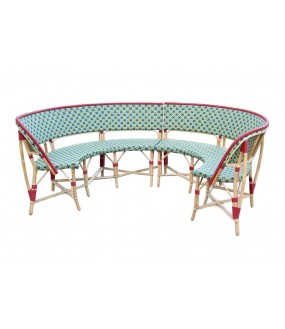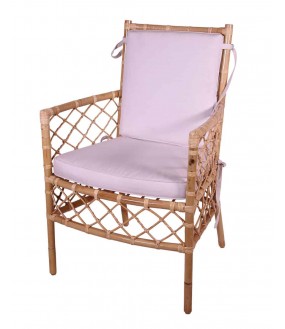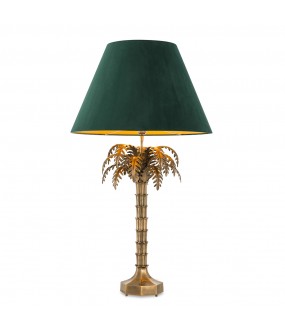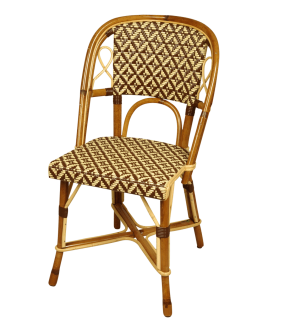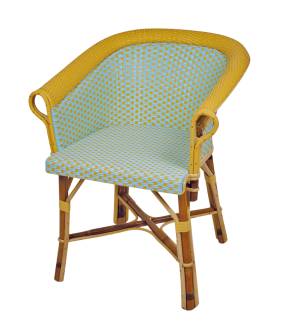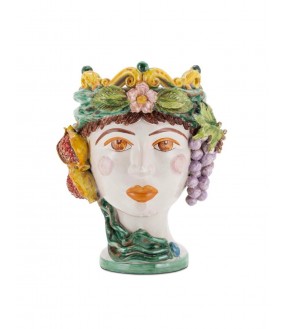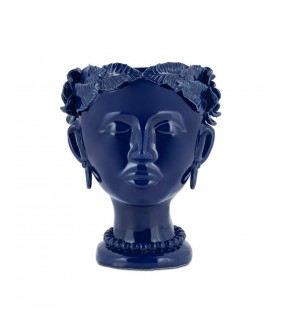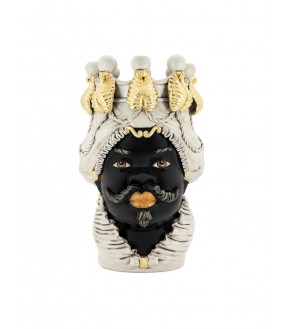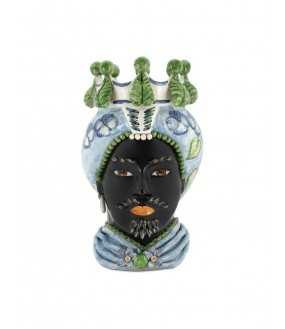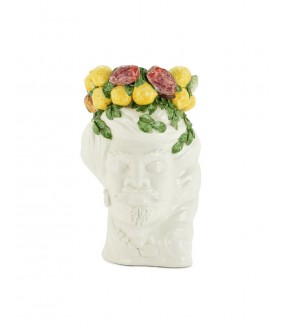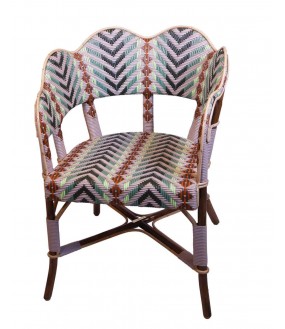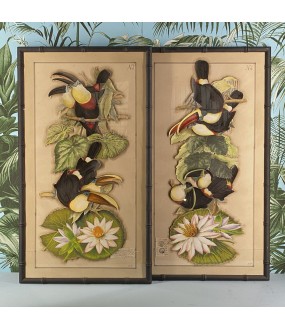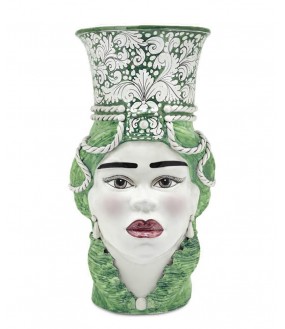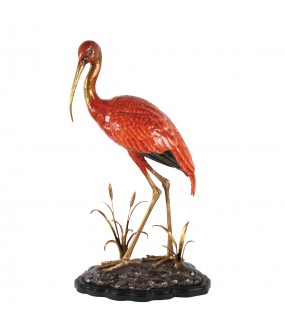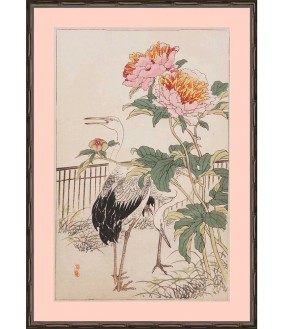Eclectic Chic
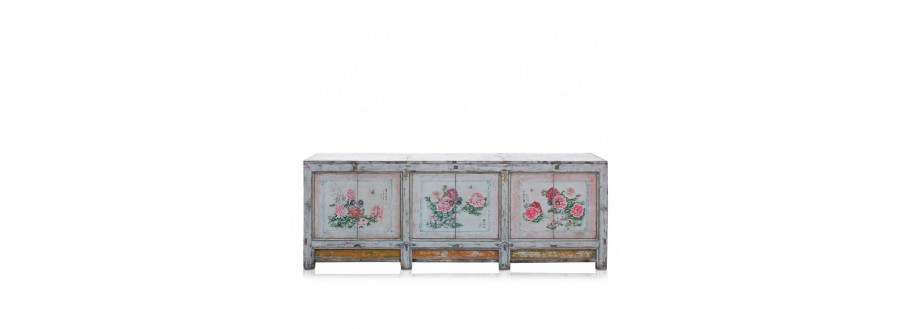
-

New Items
-

Furniture Design and Artistic Creations
-

Dining Tables
-

Dining Tables - Coffee Tables - Side Tables - Consoles - Columns
-

Seating
-

Luxury Handcrafted Rattan Seats
-

Mirrors
-

Lighting
-

Storage & Headboard
-

Home Accessories
-

Objects of Curiosities and Naturalia
-

Greco Roman Art
-

Ethnic Art from Africa, Asia-Pacific & Americas
-

Wall Art Decor
-

Rugs & Cushions
-

Vintage Furniture
-

Louis Vuitton Trunks
-

Outdoor - Jardin
-
Magnificent Rattan Chair, Made on Order
€1,398.00Superb handcrafted rattan chair, made on demand.
This cane chair is ideal for your terrace, in your garden but also for your interior.
Very comfortable, this exceptional rattan chair is light and very resistant.
This chair will beautify your living room, your kitchen, your terrace, your veranda or your restaurant.
A magnificent French craftsmanship, this chair is entirely handmade.
Type: chair with wide seat 43cm
Stackability: Not stackable
Indoor/Outdoor: Indoor, Outdoor friendly
Fiber: Satin (Raucord)
Structure materials: Dark rattan (Malacca)
Weaving range: exceptions
Colours: Satin Beige – Pantone 7502, Satin Ultramarine Blue – Pantone 534, Satin Royal Blue, Satin Terracotta, Satin Olive Green – Pantone 5743
Seat height: 45cm
Seat width: Wide seat
Overall height: 81cm
Overall width: 58cm
Overall depth: 63cm
Weight: 7kg
Varnish and paint: Varnish
Rattan, a material with extraordinary properties with limits.
Rattan is a vine of the Palm race, which grows in very humid or even swampy equatorial forests.
With its siliceous skin like glass, this extremely solid and light vine is particularly resistant to humidity, as are tropical woods, teak or others.
But this resistance has its limits. Exposed to rain, rattan resists very well for a whole day or even a few days. But if this rain continues for too many hours, the humidity will gradually penetrate the Rattan, and day after day the material kept damp will end up slowly degrading and losing its resistance qualities.
The physical limits of rattan imply precautions for use. On the terraces of Parisian cafes, the chairs can last for decades while they are often in the rain all day for long periods. But they are piled up every night under cover and can thus dry out.
More generally, rattan can withstand rain for long hours without compromising its longevity, but must be able to dry regularly.
In practice, rattan furniture can stay outside throughout the "summer season", the weather is hot and rather dry, continuous rains exceptionally last more than three or four days and Rattan withstands such rains without degrading.
But as soon as the season advances, the temperature drops, there is a lot of condensation and humidity, the Rattan will gradually become humid, the long and heavy rains accentuating this degradation. In practice, these are sensitive situations by the sea.
It is then imperative to put the seats under shelter, a ventilated shelter to avoid progressive humidification as soon as the "bad season" arrives, in practice from mid-October to mid-March for a continental climate.
The alternative if you want to use your Rattan furniture all year round, is to put it away daily, every evening, as Parisian terraces do.
In summary, 2 main principles to respect:
During the winter season (October 15 to March 15 in Europe) in all climates: the furniture must be stored “dry”. It can however be left outside during the day, but must imperatively be put in the dry during the night.
During the "beautiful season", the rest of the time, the Rattan can remain permanently outside.
However, if a lasting rain arrives, the Rattan should only be left in this rain for two or three days at the most, before putting the furniture in the dry place so that it can dry. He only takes it out once the rain has stopped (In any case, a terrace cannot be used in the rain).
-
Superb Rattan Half Moon Bench, Made to Order
Superb bench in the shape of a half moon in woven rattan is made exclusively to measure. This magnificent bench will contribute to the general atmosphere of your interior or exterior ambiance.
Handcrafted rattan bench, made to order.
Price upon request.
This marvelous cane bench is ideal for your terrace, in your garden but also for your interior.
Very comfortable, this bench is light and very resistant.
A magnificent French craftsmanship, the Guinguette bench is entirely handmade.
Custom seat.
Stackability: not stackable
Indoor/Outdoor: Semi-outdoor
Fiber: Brilliant (Rilsan)
Colours: Gloss Bordeaux, Gloss Yellow, Gloss Putty
Structure materials: Light rattan (Manila)
Weaving range: prestige
Seat height: 45cm
Overall height: custom
Overall width: custom
Overall depth: custom
Varnish and paint: Varnish
Rattan, a material with extraordinary properties with limits.
Rattan is a vine of the Palm race, which grows in very humid or even swampy equatorial forests.
With its siliceous skin like glass, this extremely solid and light vine is particularly resistant to humidity, as are tropical woods, teak or others.
But this resistance has its limits. Exposed to rain, rattan resists very well for a whole day or even a few days. But if this rain continues for too many hours, the humidity will gradually penetrate the Rattan, and day after day the material kept damp will end up slowly degrading and losing its resistance qualities.
The physical limits of rattan imply precautions for use. On the terraces of Parisian cafes, the chairs can last for decades while they are often in the rain all day for long periods. But they are piled up every night under cover and can thus dry out.
More generally, rattan can withstand rain for long hours without compromising its longevity, but must be able to dry regularly.
In practice, rattan furniture can stay outside throughout the "summer season", the weather is hot and rather dry, continuous rains exceptionally last more than three or four days and Rattan withstands such rains without degrading.
But as soon as the season advances, the temperature drops, there is a lot of condensation and humidity, the Rattan will gradually become humid, the long and heavy rains accentuating this degradation. In practice, these are sensitive situations by the sea.
It is then imperative to put the seats under shelter, a ventilated shelter to avoid progressive humidification as soon as the "bad season" arrives, in practice from mid-October to mid-March for a continental climate.
The alternative if you want to use your Rattan furniture all year round, is to put it away daily, every evening, as Parisian terraces do.
In summary, 2 main principles to respect:
During the winter season (October 15 to March 15 in Europe) in all climates: the furniture must be stored “dry”. It can however be left outside during the day, but must imperatively be put in the dry during the night.
During the "beautiful season", the rest of the time, the Rattan can remain permanently outside.
However, if a lasting rain arrives, the Rattan should only be left in this rain for two or three days at the most, before putting the furniture in the dry place so that it can dry. He only takes it out once the rain has stopped (In any case, a terrace cannot be used in the rain).
En savoir plus sur ce texte sourceVous devez indiquer le texte source pour obtenir des informations supplémentaires
Envoyer des commentaires
Panneaux latéraux
-
Natural Woven Rattan Armchair 1920s
€1,188.00This rattan armchair, all woven in natural slats, is a great vintage classic for the garden, terrace, veranda from the 1920s. Supplied with its seat cushions.
We love its retro style from the banks of the Marne in the 1900s. As beautiful inside as it is outside, this armchair will enhance your kitchen, your living room, your terrace, your veranda or your restaurant.
This natural woven rattan armchair should be kept out of the rain.
A magnificent French craftsmanship, this caned rattan armchair is entirely handmade.
Overall height: 95 cm
Overall width: 61cm
Overall depth: 78cm
Weight: 7kg
Seat height: 45cm
Seat width: Wide seat 43cm
Indoor/Outdoor: Indoor only
Stackability: Not stackable
Material: Light Rattan (Manila)
Colors: natural fiber
Rattan is a material with extraordinary properties with limits. Rattan is a vine of the Palm race, which grows in very humid or even swampy equatorial forests.
With its siliceous skin like glass, this extremely solid and light vine is particularly resistant to humidity, as are tropical woods, teak or others.
But this resistance has its limits. Exposed to rain, rattan resists very well for a whole day or even a few days. But if this rain continues for too many hours, the humidity will gradually penetrate the Rattan, and day after day the material kept damp will end up slowly degrading and losing its resistance qualities.
The physical limits of rattan imply precautions for use. On the terraces of Parisian cafes, the chairs can last for decades while they are often in the rain all day for long periods. But they are piled up every night under cover and can thus dry out.
More generally, rattan can withstand rain for long hours without compromising its longevity, but must be able to dry regularly.
In practice, rattan furniture can stay outside throughout the "summer season", the weather is hot and rather dry, continuous rains exceptionally last more than three or four days and Rattan withstands such rains without degrading.
But as soon as the season advances, the temperature drops, there is a lot of condensation and humidity, the Rattan will gradually become humid, the long and heavy rains accentuating this degradation. In practice, these are sensitive situations by the sea.
It is then imperative to put the seats under shelter, a ventilated shelter to avoid progressive humidification as soon as the "bad season" arrives, in practice from mid-October to mid-March for a continental climate.
The alternative if you want to use your Rattan furniture all year round, is to put it away daily, every evening, as Parisian terraces do.
In summary, 2 main principles to respect:
During the winter season (October 15 to March 15 in Europe) in all climates: the furniture must be stored “dry”. It can however be left outside during the day, but must imperatively be put in the dry during the night.
During the "beautiful season", the rest of the time, the Rattan can remain permanently outside.
However, if a lasting rain arrives, the Rattan should only be left in this rain for two or three days at the most, before putting the furniture in the dry place so that it can dry. He only takes it out once the rain has stopped (In any case, a terrace cannot be used in the rain).
-
Table Lamp Fauna H115cm
€1,280.00Very beautiful brass table lamp in the shape of a palm tree.
Bring tropical opulence to your interior with the Fauna Table Lamp. The base of the lamp has the shape of a palm tree and a vintage brass finish.
This botanical beauty comes complete with a conical green velvet shade.
This lamp is handcrafted in solid brass.
-
Chair in Rattan Chocolate, Made on Demand
€1,440.00The Chocolate rattan chair.
Superb handcrafted rattan chair, made on demand.
Price upon request.
This cane chair is ideal for your terrace, in your garden but also for your interior.
Very comfortable, this beautiful chair is light and very resistant.
This chair will beautify your living room, your kitchen, your terrace, your veranda or your restaurant.
A magnificent French artisanal achievement, entirely handmade.
Type: chair with wide seat 45cm
Stackability: stackable
Indoor/Outdoor: Semi-outdoor
Fiber: Brilliant (Rilsan)
Colours: Shiny Chocolate, Shiny Ivory
Structure materials: Dark rattan (Malacca)
Weaving range: Masterpieces
Seat height: 45cm
Overall height: 86cm
Overall width: 45cm
Overall depth: 51cm
Weight: 5kg
Varnish and paint: Varnish
Rattan, a material with extraordinary properties with limits.
Rattan is a vine of the Palm race, which grows in very humid or even swampy equatorial forests.
With its siliceous skin like glass, this extremely solid and light vine is particularly resistant to humidity, as are tropical woods, teak or others.
But this resistance has its limits. Exposed to rain, rattan resists very well for a whole day or even a few days. But if this rain continues for too many hours, the humidity will gradually penetrate the Rattan, and day after day the material kept damp will end up slowly degrading and losing its resistance qualities.
The physical limits of rattan imply precautions for use. On the terraces of Parisian cafes, the chairs can last for decades while they are often in the rain all day for long periods. But they are piled up every night under cover and can thus dry out.
More generally, rattan can withstand rain for long hours without compromising its longevity, but must be able to dry regularly.
In practice, rattan furniture can stay outside throughout the "summer season", the weather is hot and rather dry, continuous rains exceptionally last more than three or four days and Rattan withstands such rains without degrading.
But as soon as the season advances, the temperature drops, there is a lot of condensation and humidity, the Rattan will gradually become humid, the long and heavy rains accentuating this degradation. In practice, these are sensitive situations by the sea.
It is then imperative to put the seats under shelter, a ventilated shelter to avoid progressive humidification as soon as the "bad season" arrives, in practice from mid-October to mid-March for a continental climate.
The alternative if you want to use your Rattan furniture all year round, is to put it away daily, every evening, as Parisian terraces do.
In summary, 2 main principles to respect:
During the winter season (October 15 to March 15 in Europe) in all climates: the furniture must be stored “dry”. It can however be left outside during the day, but must imperatively be put in the dry during the night.
During the "beautiful season", the rest of the time, the Rattan can remain permanently outside.
However, if a lasting rain arrives, the Rattan should only be left in this rain for two or three days at the most, before putting the furniture in the dry place so that it can dry. He only takes it out once the rain has stopped (In any case, a terrace cannot be used in the rain).
-
Rattan Armchair Fully Woven Backrest
€1,780.00Very welcoming armchair with its fully woven backrest.
This colorfully woven rattan armchair adds a colorful and caned touch to your interiors, to your terraces, hotels, restaurants or cafés.
Indoor / Outdoor: Semi-Outdoor
Overall width: 50 cm
Overall depth: 53 cm
Overall height: 78 cm
Weight: 6kg
Seat width: Wide seat (43cm)
Seat height: 45 cm
Height of the armrests: 62 cm
Stackability: Not stackable
Availability: Made to order
Weaving fibers: Brilliant (Rilsan)
Caning range: Basic
Colours: Brilliant Azure Blue, Brilliant Cream
Varnish and paint: Varnish
Structure materials: Dark rattan (Malacca)
Alternative Structure Materials: Outdoor – Aluminum Structure, Light Rattan (Manila), Dark Rattan (Malacca)
Chassis weaving finishes: Tradition
Rattan is a material with extraordinary properties but with limits. Rattan is a vine of the Palm race, which grows in very humid or even swampy equatorial forests.
With its siliceous skin like glass, this extremely solid and light vine is particularly resistant to humidity, as are tropical woods, teak or others.
But this resistance has its limits. Exposed to rain, rattan resists very well for a whole day or even a few days. But if this rain continues for too many hours, the humidity will gradually penetrate the Rattan, and day after day the material kept damp will end up slowly degrading and losing its resistance qualities.
The physical limits of rattan imply precautions for use. On the terraces of Parisian cafes, the chairs can last for decades while they are often in the rain all day for long periods. But they are piled up every night under cover and can thus dry out.
More generally, rattan can withstand rain for long hours without compromising its longevity, but must be able to dry regularly.
In practice, rattan furniture can stay outside throughout the "summer season", the weather is hot and rather dry, continuous rains exceptionally last more than three or four days and Rattan withstands such rains without degrading.
But as soon as the season advances, the temperature drops, there is a lot of condensation and humidity, the Rattan will gradually become humid, the long and heavy rains accentuating this degradation. In practice, these are sensitive situations by the sea.
It is then imperative to put the seats under shelter, a ventilated shelter to avoid progressive humidification as soon as the "bad season" arrives, in practice from mid-October to mid-March for a continental climate.
The alternative if you want to use your Rattan furniture all year round, is to put it away daily, every evening, as Parisian terraces do.
In summary, 2 main principles to respect:
During the winter season (October 15 to March 15 in Europe) in all climates: the furniture must be stored “dry”. It can however be left outside during the day, but must imperatively be put in the dry during the night.
During the "beautiful season", the rest of the time, the Rattan can remain permanently outside.
However, if a lasting rain arrives, the Rattan should only be left in this rain for two or three days at the most, before putting the furniture in the dry place so that it can dry. He only takes it out once the rain has stopped (In any case, a terrace cannot be used in the rain).
-
Ceramic Vase, Woman Moor Head, 8 Colors
€720.00Ceramic vase, head of a Moorish woman, Sicily - Italy.
Handcrafted in ceramic, double fired and hand painted in Italy.
The moors were members of Muslim people of North Africa, of mixed Arab and Berber descent. In the 8th century they were converted to Islam and established power in North Africa, Sicily and Spain, where they established a civilization (756–1492).
THE LEGEND :
During the Arab domination in Sicily, in Palermo city, there was an Arab Suburb called "La Kalsa".
In this small suburb was living a beautiful young lady who used to spend her time in taking care of the flowers on her balcony.
One day, a young moor was walking down the lady's balcony. He noticed the beauty of the lady and he truly fell in love with her.
He did not wait a minute to declare his love for her, and the beautiful young lady, impressed by the lover's boldness, started feeling the same love.
Unfortunately, the young moor was already married and was father of a few kids... as soon as the young lady found out that he would have left for going back to his family, she waited until the night and killed him while he was sleeping deeply. She cut his head and used it as a vase for her plants, so that she could have him forever by her side.
As the beauty of this vase was magnificent, all the neighborhood wanted to own a similar one.
From that moment, they decide to create ceramics moor heads as vases.
-
Ceramic Vase, Woman Moor Head, Mix Colors
€690.00Ceramic vase, head of a Moorish woman, Sicily - Italy.
Handcrafted in ceramic, double fired and hand painted in Italy.
The moors were members of Muslim people of North Africa, of mixed Arab and Berber descent. In the 8th century they were converted to Islam and established power in North Africa, Sicily and Spain, where they established a civilization (756–1492).
THE LEGEND :
During the Arab domination in Sicily, in Palermo city, there was an Arab Suburb called "La Kalsa".
In this small suburb was living a beautiful young lady who used to spend her time in taking care of the flowers on her balcony.
One day, a young moor was walking down the lady's balcony. He noticed the beauty of the lady and he truly fell in love with her.
He did not wait a minute to declare his love for her, and the beautiful young lady, impressed by the lover's boldness, started feeling the same love.
Unfortunately, the young moor was already married and was father of a few kids... as soon as the young lady found out that he would have left for going back to his family, she waited until the night and killed him while he was sleeping deeply. She cut his head and used it as a vase for her plants, so that she could have him forever by her side.
As the beauty of this vase was magnificent, all the neighborhood wanted to own a similar one.
From that moment, they decide to create ceramics moor heads as vases.
-
Ceramic Vase, Woman Moor Head
€800.00Ceramic vase, head of a Moorish woman, Sicily - Italy.
Handcrafted in ceramic, double fired and hand painted in Italy.
The moors were members of Muslim people of North Africa, of mixed Arab and Berber descent. In the 8th century they were converted to Islam and established power in North Africa, Sicily and Spain, where they established a civilization (756–1492).
THE LEGEND :
During the Arab domination in Sicily, in Palermo city, there was an Arab Suburb called "La Kalsa".
In this small suburb was living a beautiful young lady who used to spend her time in taking care of the flowers on her balcony.
One day, a young moor was walking down the lady's balcony. He noticed the beauty of the lady and he truly fell in love with her.
He did not wait a minute to declare his love for her, and the beautiful young lady, impressed by the lover's boldness, started feeling the same love.
Unfortunately, the young moor was already married and was father of a few kids... as soon as the young lady found out that he would have left for going back to his family, she waited until the night and killed him while he was sleeping deeply. She cut his head and used it as a vase for her plants, so that she could have him forever by her side.
As the beauty of this vase was magnificent, all the neighborhood wanted to own a similar one.
From that moment, they decide to create ceramics moor heads as vases.
-
Ceramic Vase, Paladin Woman Moor Head
€780.00Ceramic vase, head of a Paladin Moorish woman, Sicily - Italy.
The paladin is a knight who has reached one of the highest ranks, is part of a religious order and bears the sacred power of faith.
Handcrafted in ceramic, double fired and hand painted in Italy.
The moors were members of Muslim people of North Africa, of mixed Arab and Berber descent. In the 8th century they were converted to Islam and established power in North Africa, Sicily and Spain, where they established a civilization (756–1492).
THE LEGEND :
During the Arab domination in Sicily, in Palermo city, there was an Arab Suburb called "La Kalsa".
In this small suburb was living a beautiful young lady who used to spend her time in taking care of the flowers on her balcony.
One day, a young moor was walking down the lady's balcony. He noticed the beauty of the lady and he truly fell in love with her.
He did not wait a minute to declare his love for her, and the beautiful young lady, impressed by the lover's boldness, started feeling the same love.
Unfortunately, the young moor was already married and was father of a few kids... as soon as the young lady found out that he would have left for going back to his family, she waited until the night and killed him while he was sleeping deeply. She cut his head and used it as a vase for her plants, so that she could have him forever by her side.
As the beauty of this vase was magnificent, all the neighborhood wanted to own a similar one.
From that moment, they decide to create ceramics moor heads as vases.
-
Table Lamp Empire
€740.00Very beautiful table lamp in black lacquered wood and its beautiful printed cotton lampshade with fringes.
Bring tropical, animalistic opulence to your interior with the Empire table lamp. The base of the lamp is in black glass.
The cotton velvet lampshade brings botanical and animal style and beauty.
This lamp is handcrafted in Italy.
Available in two lampshade versions: black or white background.
-
Ceramic Vase, Woman Moor Head
€800.00Ceramic vase, head of a Moorish woman, Sicily - Italy.
Head-shaped vase, Italian-made to the smallest detail, all decorations are applied and hand painted making each piece unique.
Handcrafted in ceramic, double fired and hand painted in Italy.
The moors were members of Muslim people of North Africa, of mixed Arab and Berber descent. In the 8th century they were converted to Islam and established power in North Africa, Sicily and Spain, where they established a civilization (756–1492).
THE LEGEND :
During the Arab domination in Sicily, in Palermo city, there was an Arab Suburb called "La Kalsa".
In this small suburb was living a beautiful young lady who used to spend her time in taking care of the flowers on her balcony.
One day, a young moor was walking down the lady's balcony. He noticed the beauty of the lady and he truly fell in love with her.
He did not wait a minute to declare his love for her, and the beautiful young lady, impressed by the lover's boldness, started feeling the same love.
Unfortunately, the young moor was already married and was father of a few kids... as soon as the young lady found out that he would have left for going back to his family, she waited until the night and killed him while he was sleeping deeply. She cut his head and used it as a vase for her plants, so that she could have him forever by her side.
As the beauty of this vase was magnificent, all the neighborhood wanted to own a similar one.
From that moment, they decide to create ceramics moor heads as vases.
-
Ceramic Vase, Moor Head Man - H48cm
€990.00Ceramic vase, head of a Moorish man, a traditional Sicilian achievement - Italy. This magnificent vase is produced and painted by hand in Caltagirone in Sicily and distributed exclusively by Arteslonga.
Handcrafted in ceramic, double firing. Entirely made and painted by hand in Caltagirone (Italy).
The Moors were members of the Muslim people of North Africa, of mixed Arab and Berber origin. In the 8th century they were converted to Islam and established power in North Africa, Sicily and Spain, where they established a civilization (756-1492).
THE LEGEND :
During the Arab domination in Sicily, in the city of Palermo there was an Arab suburb called "La Kalsa".
In this small suburb lived a beautiful young woman who spent her time tending to the flowers on her balcony.
One day a young Moor was walking under the lady's balcony. He noticed the beauty of the young lady and he fell in love with her.
He did not wait a minute to declare his love and the beautiful young girl, impressed by the audacity of the lover, quickly experienced the same love.
Unfortunately, the young Moor was already married and had several children ... as soon as the young woman found out that he could leave to find his family, one day she waited for night and killed him while he slept soundly. She cut off his head and used it as a vase for her plants so she could have him forever by her side.
As the beauty of this vase was remarkable, the whole neighborhood wanted to own a similar one.
From this moment, the creation of vases in the shape of the heads of Moors began...
-
Ceramic Vase, Man Moor Blue and Lilac
€900.00Man Moor Head Vase made in ceramic Lilac and Blue, made in Sicily - Italy. Old ancient finishing, ceramic, double cooking entirely made and painted by hand in Caltagirone. The moors were members of Muslim people of North Africa, of mixed Arab and Berber descent.
-
Ceramic Vase, Moor Head Man - H48cm
€990.00Ceramic vase, head of a Moorish man, a traditional Sicilian achievement - Italy. This magnificent vase is produced and painted by hand in Caltagirone in Sicily and distributed exclusively by Arteslonga.
Handcrafted in ceramic, double firing. Entirely made and painted by hand in Caltagirone (Italy).
The Moors were members of the Muslim people of North Africa, of mixed Arab and Berber origin. In the 8th century they were converted to Islam and established power in North Africa, Sicily and Spain, where they established a civilization (756-1492).
THE LEGEND :
During the Arab domination in Sicily, in the city of Palermo there was an Arab suburb called "La Kalsa".
In this small suburb lived a beautiful young woman who spent her time tending to the flowers on her balcony.
One day a young Moor was walking under the lady's balcony. He noticed the beauty of the young lady and he fell in love with her.
He did not wait a minute to declare his love and the beautiful young girl, impressed by the audacity of the lover, quickly experienced the same love.
Unfortunately, the young Moor was already married and had several children ... as soon as the young woman found out that he could leave to find his family, one day she waited for night and killed him while he slept soundly. She cut off his head and used it as a vase for her plants so she could have him forever by her side.
As the beauty of this vase was remarkable, the whole neighborhood wanted to own a similar one.
From this moment, the creation of vases in the shape of the heads of Moors began...
-
Ceramic Vase, Moor Man Head with Lemons
€670.01Ceramic vase, male Moor's head with representation of beautiful yellow lemons, made entirely by hand in Sicily - Italy.
Handcrafted in ceramic, double firing and hand painted.
The Moors were members of the Muslim people of North Africa, of mixed Arab and Berber origin. In the 8th century they were converted to Islam and established power in North Africa, Sicily and Spain, where they established a civilization (756-1492).
THE LEGEND :
During the Arab domination in Sicily, in the city of Palermo there was an Arab suburb called "La Kalsa".
In this small suburb lived a beautiful young woman who spent her time tending to the flowers on her balcony.
One day a young Moor was walking under the lady's balcony. He noticed the beauty of the young lady and he fell in love with her.
He did not wait a minute to declare his love and the beautiful young girl, impressed by the audacity of the lover, quickly experienced the same love.
Unfortunately, the young Moor was already married and had several children ... as soon as the young woman found out that he could leave to find his family, one day she waited for night and killed him while he slept soundly. She cut off his head and used it as a vase for her plants so she could have him forever by her side.
As the beauty of this vase was remarkable, the whole neighborhood wanted to own a similar one.
From this moment, the creation of vases in the shape of the heads of Moors began...
-
Ceramic Vase, Woman Moor Head
€800.01Ceramic vase, head of a Moorish woman, Sicily - Italy.
Handcrafted in ceramic, double fired and hand painted in Italy.
The moors were members of Muslim people of North Africa, of mixed Arab and Berber descent. In the 8th century they were converted to Islam and established power in North Africa, Sicily and Spain, where they established a civilization (756–1492).
THE LEGEND :
During the Arab domination in Sicily, in Palermo city, there was an Arab Suburb called "La Kalsa".
In this small suburb was living a beautiful young lady who used to spend her time in taking care of the flowers on her balcony.
One day, a young moor was walking down the lady's balcony. He noticed the beauty of the lady and he truly fell in love with her.
He did not wait a minute to declare his love for her, and the beautiful young lady, impressed by the lover's boldness, started feeling the same love.
Unfortunately, the young moor was already married and was father of a few kids... as soon as the young lady found out that he would have left for going back to his family, she waited until the night and killed him while he was sleeping deeply. She cut his head and used it as a vase for her plants, so that she could have him forever by her side.
As the beauty of this vase was magnificent, all the neighborhood wanted to own a similar one.
From that moment, they decide to create ceramics moor heads as vases.
-
Rattan Armchair Green, Made On Order
€1,780.00The Gabrielle chair. Superb handcrafted armchair in woven rattan.
Manufacturing on demand.
Welcoming with its fully woven backrest and its generous shapes, the Gabrielle armchair is an armchair for restaurants, bistros, cafés, gardens or dining rooms in woven rattan in the colors of your desires, non-stackable and is as beautiful inside as it is outside.
Very comfortable, the Gabrielle armchair is light and very resistant.
This armchair will beautify your living room, your kitchen, your terrace, your veranda or your restaurant.
A magnificent French craftsmanship, the Gabrielle armchair is entirely handmade.
Type: chair with wide seat 43cm
Stackability: Not stackable
Indoor/Outdoor: Semi-Outdoor
Fiber: Satin (Raucord)
Colours: Satin Beige – Pantone 7502, Satin Ultramarine Blue – Pantone 534, Satin Royal Blue, Satin Terracotta, Satin Olive Green – Pantone 5743
Structure materials: Dark rattan (Malacca)
Weaving range: exceptions
Colours: Satin Beige – Pantone 7502, Satin Ultramarine Blue – Pantone 534, Satin Royal Blue, Satin Terracotta, Satin Olive Green – Pantone 5743
Seat height: 45cm
Seat width: Wide seat (43 cm).
Overall height: 81cm
Overall width: 58cm
Overall depth: 63cm
Weight: 7kg
Varnish and paint: Varnish
Rattan, a material with extraordinary properties with limits.
Rattan is a vine of the Palm race, which grows in very humid or even swampy equatorial forests.
With its siliceous skin like glass, this extremely solid and light vine is particularly resistant to humidity, as are tropical woods, teak or others.
But this resistance has its limits. Exposed to rain, rattan resists very well for a whole day or even a few days. But if this rain continues for too many hours, the humidity will gradually penetrate the Rattan, and day after day the material kept damp will end up slowly degrading and losing its resistance qualities.
The physical limits of rattan imply precautions for use. On the terraces of Parisian cafes, the chairs can last for decades while they are often in the rain all day for long periods. But they are piled up every night under cover and can thus dry out.
More generally, rattan can withstand rain for long hours without compromising its longevity, but must be able to dry regularly.
In practice, rattan furniture can stay outside throughout the "summer season", the weather is hot and rather dry, continuous rains exceptionally last more than three or four days and Rattan withstands such rains without degrading.
But as soon as the season advances, the temperature drops, there is a lot of condensation and humidity, the Rattan will gradually become humid, the long and heavy rains accentuating this degradation. In practice, these are sensitive situations by the sea.
It is then imperative to put the seats under shelter, a ventilated shelter to avoid progressive humidification as soon as the "bad season" arrives, in practice from mid-October to mid-March for a continental climate.
The alternative if you want to use your Rattan furniture all year round, is to put it away daily, every evening, as Parisian terraces do.
In summary, 2 main principles to respect:
During the winter season (October 15 to March 15 in Europe) in all climates: the furniture must be stored “dry”. It can however be left outside during the day, but must imperatively be put in the dry during the night.
During the "beautiful season", the rest of the time, the Rattan can remain permanently outside.
However, if a lasting rain arrives, the Rattan should only be left in this rain for two or three days at the most, before putting the furniture in the dry place so that it can dry. He only takes it out once the rain has stopped (In any case, a terrace cannot be used in the rain).
En savoir plus sur ce texte sourceVous devez indiquer le texte source pour obtenir des informations supplémentaires
Envoyer des commentaires
Panneaux latéraux
-
Magnificent Green Rattan Chair, Made on Order
€1,398.00Superb handcrafted rattan chair, made on demand.
This cane chair is ideal for your terrace, in your garden but also for your interior.
Very comfortable, this exceptional rattan chair is light and very resistant.
This chair will beautify your living room, your kitchen, your terrace, your veranda or your restaurant.
A magnificent French craftsmanship, this chair is entirely handmade.
Type: chair with wide seat 43cm
Stackability: Not stackable
Indoor/Outdoor: Indoor, Outdoor friendly
Fiber: Satin (Raucord)
Structure materials: Dark rattan (Malacca)
Weaving range: exceptions
Colours: Satin Beige – Pantone 7502, Satin Ultramarine Blue – Pantone 534, Satin Royal Blue, Satin Terracotta, Satin Olive Green – Pantone 5743
Seat height: 45cm
Seat width: Wide seat
Overall height: 81cm
Overall width: 58cm
Overall depth: 63cm
Weight: 7kg
Varnish and paint: Varnish
Rattan, a material with extraordinary properties with limits.
Rattan is a vine of the Palm race, which grows in very humid or even swampy equatorial forests.
With its siliceous skin like glass, this extremely solid and light vine is particularly resistant to humidity, as are tropical woods, teak or others.
But this resistance has its limits. Exposed to rain, rattan resists very well for a whole day or even a few days. But if this rain continues for too many hours, the humidity will gradually penetrate the Rattan, and day after day the material kept damp will end up slowly degrading and losing its resistance qualities.
The physical limits of rattan imply precautions for use. On the terraces of Parisian cafes, the chairs can last for decades while they are often in the rain all day for long periods. But they are piled up every night under cover and can thus dry out.
More generally, rattan can withstand rain for long hours without compromising its longevity, but must be able to dry regularly.
In practice, rattan furniture can stay outside throughout the "summer season", the weather is hot and rather dry, continuous rains exceptionally last more than three or four days and Rattan withstands such rains without degrading.
But as soon as the season advances, the temperature drops, there is a lot of condensation and humidity, the Rattan will gradually become humid, the long and heavy rains accentuating this degradation. In practice, these are sensitive situations by the sea.
It is then imperative to put the seats under shelter, a ventilated shelter to avoid progressive humidification as soon as the "bad season" arrives, in practice from mid-October to mid-March for a continental climate.
The alternative if you want to use your Rattan furniture all year round, is to put it away daily, every evening, as Parisian terraces do.
In summary, 2 main principles to respect:
During the winter season (October 15 to March 15 in Europe) in all climates: the furniture must be stored “dry”. It can however be left outside during the day, but must imperatively be put in the dry during the night.
During the "beautiful season", the rest of the time, the Rattan can remain permanently outside.
However, if a lasting rain arrives, the Rattan should only be left in this rain for two or three days at the most, before putting the furniture in the dry place so that it can dry. He only takes it out once the rain has stopped (In any case, a terrace cannot be used in the rain).
-
Chair in Rattan Albertine, Made on Demand
€1,032.00The Albertine rattan chair.
Superb handcrafted rattan chair, made to order and which can be woven in your colors on request.
It is stackable, robust and light, CHR furniture par excellence.
The Albertine chair is one of the essential rattan chairs that adorns Parisian, Eastern and Western terraces.
Price upon request.
This cane chair is ideal for your terrace, in your garden but also for your interior.
Very comfortable, this beautiful chair is light and very resistant.
This chair will beautify your living room, your kitchen, your terrace, your veranda or your restaurant.
A magnificent French artisanal creation, entirely handmade.
Type: chair with 45cm wide seat
Stackability: stackable
Indoor/Outdoor: Semi-outdoor
Fiber: Brilliant (Rilsan)
Colors: Glossy Burgundy and Glossy Cream
Structure materials: Dark rattan (Malacca)
Weaving range: Classic
Seat height: 45cm
Overall height: 78cm
Overall width: 45cm
Overall depth: 51cm
Weight: 5kg
Varnish and paint: Varnish
Rattan, a material with extraordinary properties with limits.
Rattan is a vine of the Palm race, which grows in very humid or even marshy Equatorial forests.
With its glass-like siliceous skin, this extremely strong and light vine is particularly resistant to humidity, as are tropical woods, teak or others.
But this resistance has limits. Exposed to rain, rattan resists very well for a whole day or even a few days. But if this rain continues for too many hours, the humidity will gradually penetrate the Rattan, and day after day the material kept wet will end up slowly deteriorating and losing its resistance qualities.
The physical limits of rattan require precautions for use. On the terraces of Parisian cafes, the chairs can last for decades even though they are often in the rain all day for long periods. But they are stacked under cover every evening and can thus dry.
More generally, rattan can withstand rain for long hours without compromising its longevity, but must be able to dry regularly.
In practice, rattan furniture can remain outside throughout the “summer season”, the weather is hot and rather dry, continuous rains exceptionally last more than three or four days and Rattan withstands such rain without deteriorating.
But as soon as the season advances, the temperature drops, and there is a lot of condensation and humidity, the Rattan will gradually become humid, with long, heavy rains accentuating this deterioration. In practice, these are sensitive situations at the seaside.
It is then imperative to place the seats under shelter, a ventilated shelter to avoid progressive humidification as soon as the “bad season” arrives, in practice from mid-October to mid-March for a continental climate.
The alternative if you want to use your rattan furniture all year round is to put it under cover every day, every evening, as the Parisian terraces do.
In summary, 2 main principles to respect:
During the winter season (October 15 to March 15 in Europe) in all climates: furniture must be stored “dry”. It can, however, be left outside during the day, but must be kept dry overnight.
During the “summer season”, the rest of the time, Rattan can remain permanently outside.
However, if there is lasting rain, you should only leave the Rattan in this rain for two or three days at most, before putting the furniture in a dry place so that it can dry. Only take it out once the rain has stopped (In any case, a terrace cannot be used in the rain).
-
Toucans Engravings Made by Collages
€2,990.00A pair of magnificent Toucans engravings made from collages of old juxtaposed engravings which are previously hand painted.
A magnificent artisanal work of remarkable finesse executed in Italy according to an ancestral process.
Within each frame an atmosphere is created by a juxtaposition of exquisite hand engravings which are engraved and printed on vintage presses from the 1800s.
Each image is printed in black and white, individually hand colored with gouache and in watercolor then cut out.
Superb and one of a kind.
-
Ceramic Vase, Green Woman Moor Head
€900.00Ceramic vase, head of a Moorish woman, Sicily - Italy.
Handcrafted in ceramic, double fired and hand painted in Italy.
The moors were members of Muslim people of North Africa, of mixed Arab and Berber descent. In the 8th century they were converted to Islam and established power in North Africa, Sicily and Spain, where they established a civilization (756–1492).
THE LEGEND :
During the Arab domination in Sicily, in Palermo city, there was an Arab Suburb called "La Kalsa".
In this small suburb was living a beautiful young lady who used to spend her time in taking care of the flowers on her balcony.
One day, a young moor was walking down the lady's balcony. He noticed the beauty of the lady and he truly fell in love with her.
He did not wait a minute to declare his love for her, and the beautiful young lady, impressed by the lover's boldness, started feeling the same love.
Unfortunately, the young moor was already married and was father of a few kids... as soon as the young lady found out that he would have left for going back to his family, she waited until the night and killed him while he was sleeping deeply. She cut his head and used it as a vase for her plants, so that she could have him forever by her side.
As the beauty of this vase was magnificent, all the neighborhood wanted to own a similar one.
From that moment, they decide to create ceramics moor heads as vases.
-
Giant Ceramic Vase Woman Moor Head
€2,500.00Magnificent traditional ceramic vase in the shape of a Moorish woman's head in green or malachite color - Italy. An extreme delicacy.
Handcrafted in ceramic, double fired. Completely made and painted by hand by the original artisan producer from Caltagirone - Sicily.
Distributed exclusively by Arteslonga.
The Moors were members of the Muslim people of North Africa, of mixed Arab and Berber origin. In the 8th century, they converted to Islam and established power in North Africa, Sicily and Spain, where they established a civilization (756-1492).
THE LEGEND :
During the Arab rule in Sicily, in the city of Palermo there was an Arab suburb called "La Kalsa".
In this small suburb there lived a beautiful young woman who spent her time taking care of the flowers on her balcony.
One day, a young Moor was walking under the lady's balcony. He noticed the beauty of the young lady and he fell in love with her.
He did not wait a minute to declare his love and the beautiful young girl, impressed by the lover's audacity, quickly felt the same love.
Unfortunately, the young Moor was already married and was the father of several children... as soon as the young woman discovered that he might leave to find his family one day, she waited until nightfall and killed him while he was sound asleep. She cut off his head and used it as a vase for her plants so that she could have him by her side forever.
As the beauty of this vase was remarkable, the whole neighborhood wanted to own one like it.
From this moment, the creation of vases in the shape of Moorish heads began...
-
Moor Ceramic Vase, Matt Mud Color
€1,200.00Ceramic vase, male Moor's head with representation of beautiful yellow lemons, made entirely by hand in Sicily - Italy.
Handcrafted in ceramic, double firing and hand painted.
The Moors were members of the Muslim people of North Africa, of mixed Arab and Berber origin. In the 8th century they were converted to Islam and established power in North Africa, Sicily and Spain, where they established a civilization (756-1492).
THE LEGEND :
During the Arab domination in Sicily, in the city of Palermo there was an Arab suburb called "La Kalsa".
In this small suburb lived a beautiful young woman who spent her time tending to the flowers on her balcony.
One day a young Moor was walking under the lady's balcony. He noticed the beauty of the young lady and he fell in love with her.
He did not wait a minute to declare his love and the beautiful young girl, impressed by the audacity of the lover, quickly experienced the same love.
Unfortunately, the young Moor was already married and had several children ... as soon as the young woman found out that he could leave to find his family, one day she waited for night and killed him while he slept soundly. She cut off his head and used it as a vase for her plants so she could have him forever by her side.
As the beauty of this vase was remarkable, the whole neighborhood wanted to own a similar one.
From this moment, the creation of vases in the shape of the heads of Moors began...
-
Red Crane in Porcelain and Brass, 70cm high
€2,200.00Superb figurine of a flamboyant red crane made of porcelain and brass, 70cm high and 46cm wide.
A contemporary artisanal work of great beauty.
The bird's legs are made of brass.
A remarkable piece for a refined and unique interior decoration.
-
Engravings by K. Baerei, 19th C. Set of 2
€530.00A set of two beautiful engravings by the 19th century Japanese artist Kono Baerei.
Engravings with black marie-louise and very beautiful frame in aged black wood and gold edging or with a large pink marie-louise and a thin black bamboo imitation frame.
Glass size: 55x80cm
Engravings representing cranes and beautiful peonies under glass.
Bairei became a student of the Maruyama school painter Nakajima Raishō at the age of eight, and then a student of the Shijō school painter Shiokawa Bunrin at the age of twenty-seven. He continued his education in the Nanga school style under Nakanishi Kōseki and Maeda Chōdō. With Gennyo, abbot of Higashi Hongan-ji, he traveled throughout Kyūshū and central Japan, making numerous drawings.
In 1878, Bairei began preparations for an art school, which opened in 1880 as the Kyoto Prefectural School of Painting. He left this school in 1881 and taught his students in his workshop until 1891. In 1893, he became a member of the Arts Committee of the Imperial Household. In 1894, he was commissioned to paint pieces of Higashi Hongan-ji.
Bairei was a prominent figure in Kyoto's artistic circles, where he organized and promoted artistic activities. He played a particularly important role in his educational work. His many students include Takeuchi Seihō, Kikuchi Hōbun, Kawai Gyokudō.
His own work, often characterized by bold brushstrokes, displays traditional charm and sensitivity.
Its flowers, birds (Kachō-ga), and landscapes show a touch of Western realism. Bairei is also known for his spontaneous woodcut sketches.




